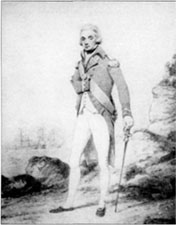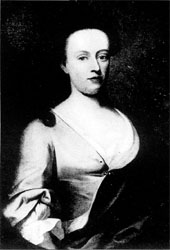Nelson (167 page)
Authors: John Sugden
XEBEC A small, three-masted vessel with both square and lateen sails
YARD A spar across a mast, supporting a sail
YAWL A yacht or small sailing boat
YEOMAN OF THE POWDER ROOM A petty officer with responsibility for the magazine

1. Captain Horatio Nelson, aged twenty-two, painted by John Francis Rigaud in 1781. He stood proudly in the full-dress uniform of a post-captain, with Fort San Juan in the background, commemorating his most notable achievement thus far.

2. Rear Admiral Sir Horatio Nelson, K.B., 1797. This pencil-and-ink drawing made by Henry Edridge in London has the appearance of being the foundation for a new commemorative portrait that was never painted. Nelson wore the undress uniform of a rear admiral, and the gold medal and red ribbon of Bath, awarded him for the victory off Cape St. Vincent, featured in the background. Note the ribbons tying the slashed sleeve over his injured arm.

3. The Reverend Edmund Nelson (1722–1802), Nelson’s father, painted by Sir William Beechey two years before the reverend’s death.

4. Catherine Nelson (1725–67), Nelson’s mother, painted by John Theodore Heins (then based in Norwich). She died leaving her husband five sons and three daughters.

5. Ann Suckling (1691–1768), Nelson’s maternal grandmother. It was through her that the Nelsons inherited their principal social influence. The daughter of Sir Charles Turner and Mary Walpole, Ann was the niece of the first Baron Walpole and Sir Robert Walpole. She outlived her daughter, Catherine, by ten days, and died at Burnham Thorpe.

6. Nelson’s Norfolk, from Faden’s map, surveyed during the years Nelson resided at Burnham Thorpe rectory as an unemployed captain. It shows the exact location of the rectory and its gatehouse, south of Burnham Thorpe.

7. The rectory at Burnham Thorpe, Nelson’s birthplace, was demolished in about 1804. A neighbour reputedly made this wash and sketch from memory in 1806, though it may have been based upon an oil miniature of 1760.

8. Norwich Grammar School, to the left of the chapel, attended by William and Horatio Nelson about 1768.

9. The Sir William Paston Grammar School, North Walsham. On the right the yard at the rear of the school, with its gate leading to the town centre, can be seen. The main entrance appears to have been elaborated since Nelson’s day, several windows bricked up, and an annexe built on the left-hand side, but the school retains much of its eighteenth-century character. Photograph taken by the author in 2002.

10. Captain Maurice Suckling (1728–78), Nelson’s uncle and patron, portrayed at Woodton Hall, Norfolk, in 1764 by Thomas Bardwell, the son of one of the Suckling family servants.

11. Skeffington Lutwidge, who took the fifteen-year-old Nelson aboard the
Carcass
in 1773. He died an admiral in 1814.
